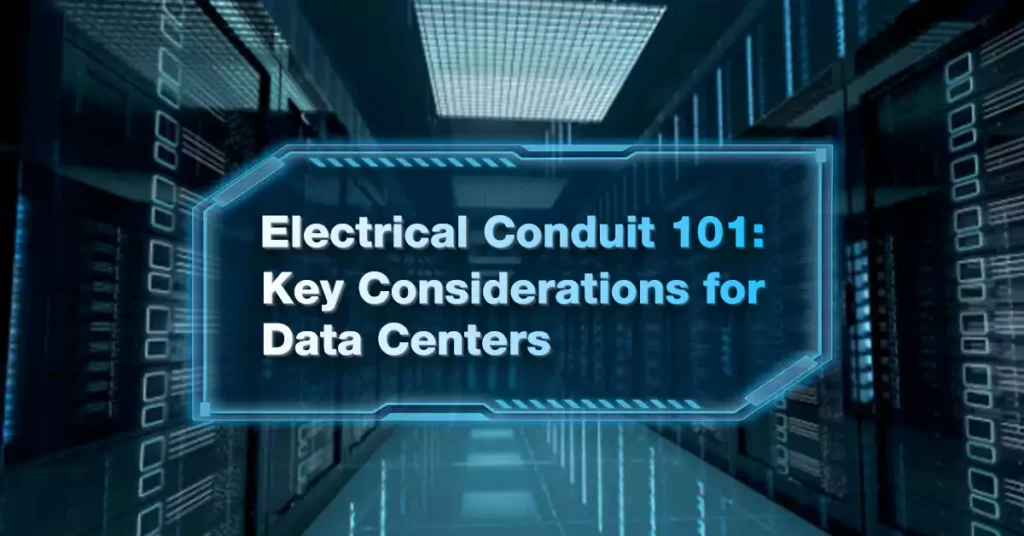
Tabla de contenido
In today’s digital-first world, data centers have become critical hubs for storing, managing, and processing vast amounts of information. These facilities support essential services, from cloud storage and online communications to real-time financial transactions and AI processing. With data centers operating 24/7, maintaining a reliable and secure electrical infrastructure is paramount. One often overlooked but vital component of this infrastructure is the electrical conduit system.
Electrical conduits serve a crucial role in data centers by housing and protecting electrical wiring and communication cables. A well-planned conduit system ensures not only physical protection but also aids in compliance with safety and operational standards. In this guide, we will delve into the essentials of electrical conduits in data centers, examining how they contribute to overall reliability and efficiency.
¿Qué es un conducto eléctrico?
At its core, an electrical conduit is a tube or duct used to route and protect electrical wiring. Made from materials such as PVC, steel, aluminum, or flexible plastics, conduits provide a barrier against physical damage, moisture, chemical exposure, and electrical interference.
In data centers, electrical conduits take on an even greater significance. These high-density facilities must manage not just standard electrical wiring but also complex arrays of communication cables for network connectivity. The integrity of these cables is essential for the seamless operation of data center services. Electrical conduits provide a structured path for these cables, helping maintain order, prevent tangling, and mitigate the risk of damage or disruption from external forces.
Electrical Conduit Applications in Data Centers:
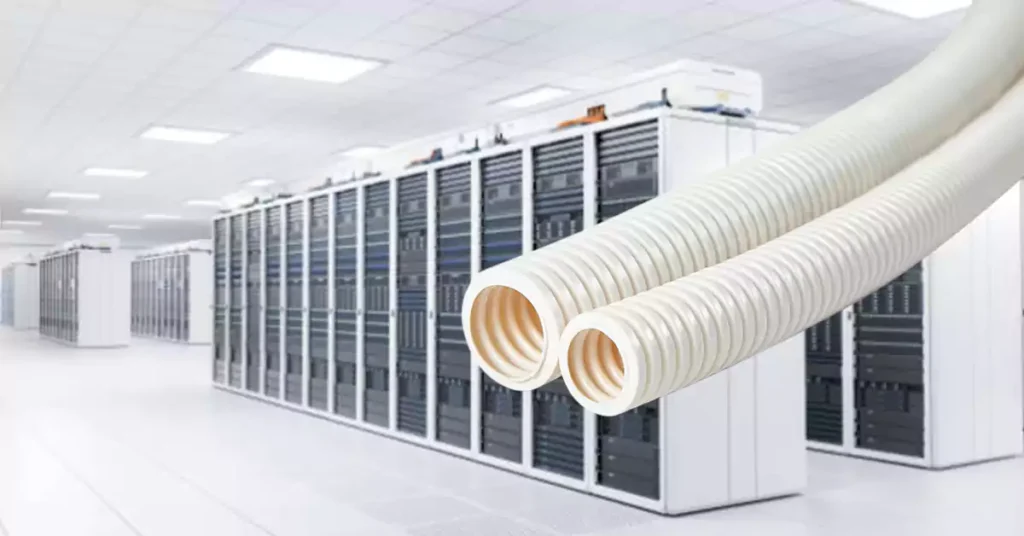
Power Protection: Conduits ensure the safety of power distribution lines that feed servers, cooling systems, and auxiliary equipment. A reliable conduit setup prevents physical damage, electrical faults, and potential fire hazards.
Communication and Data Line Protection: Network cables, including Ethernet and fiber optic lines, are lifelines for data center operations. By housing these cables in conduits, data centers can protect them from physical impact, moisture, and electromagnetic interference (EMI), all of which could lead to data transmission errors or disruptions.
Orderly Cable Management: With thousands of cables running throughout a typical data center, proper organization is crucial. Electrical conduits help create designated pathways for wiring, reducing clutter and facilitating easier maintenance and upgrades.
The Surge of AI and Its Impact on Data Center Power Needs
The Rapid Expansion of Artificial Intelligence
Artificial intelligence (AI) has quickly evolved from a specialized niche to a key driver of innovation in industries such as finance, healthcare, transportation, and technology. AI’s ability to automate complex tasks, analyze massive amounts of data, and generate valuable insights has spurred widespread adoption. However, the rise of AI has brought a substantial increase in power consumption, putting immense pressure on data centers to keep pace.
The driving forces behind this surge in computational demand include advancements in machine learning (ML) y deep learning (DL) models. These models, which often comprise billions of parameters, require extensive processing power for both training and real-time applications. The infrastructure needed to support such intensive operations has become a significant focal point for data centers around the world.
Why AI Is Fueling an Increase in Power Consumption
- Larger AI Models and Training Cycles: AI models have grown exponentially in size. For example, models like GPT-3 feature 175 billion parameters, demanding enormous amounts of computational resources. Training these models requires significant processing power over days or weeks, consuming vast amounts of electricity.
- Data Volume and Scalability: The vast datasets used in AI model training increase the power requirements of data centers. The data volume necessitates specialized hardware such as GPUs y TPUs that are more power-intensive than traditional CPUs.
- Constant Innovation and Upgrades: The competitive landscape of AI research drives the need for ongoing updates to data center infrastructure. The introduction of new architectures and more sophisticated algorithms requires data centers to support higher energy demands and adapt quickly to new standards.
Key Challenges for Data Center Energy Management
The growth in AI technology introduces several power-related challenges for data centers:
- High Energy Use and Operational Costs: AI workloads can consume massive amounts of energy. Training a single large AI model can use as much electricity as thousands of households over a year. This leads to significantly higher operational costs and places a heavy demand on local power grids.
- Sustainability and Carbon Emissions: The environmental impact of powering AI-centric data centers is a growing concern. Currently, data centers are estimated to be responsible for about 1% of global carbon emissions, with this percentage expected to rise as AI adoption continues. This has made energy efficiency and sustainability a top priority for data center operators.
- Existing Infrastructure Strain: The rapid growth of AI has outpaced existing power infrastructure capabilities. This results in challenges related to voltage stability, frequency control, and power distribution, which can impact the reliability of data center operations.
- Cooling and Heat Management: High-density computing used for AI training generates significant heat. Efficient cooling is essential, as cooling systems can account for up to 40% of total energy usage in data centers. Addressing these cooling demands without exacerbating energy consumption is a complex challenge.
Solutions to Meet the Power Demands of AI
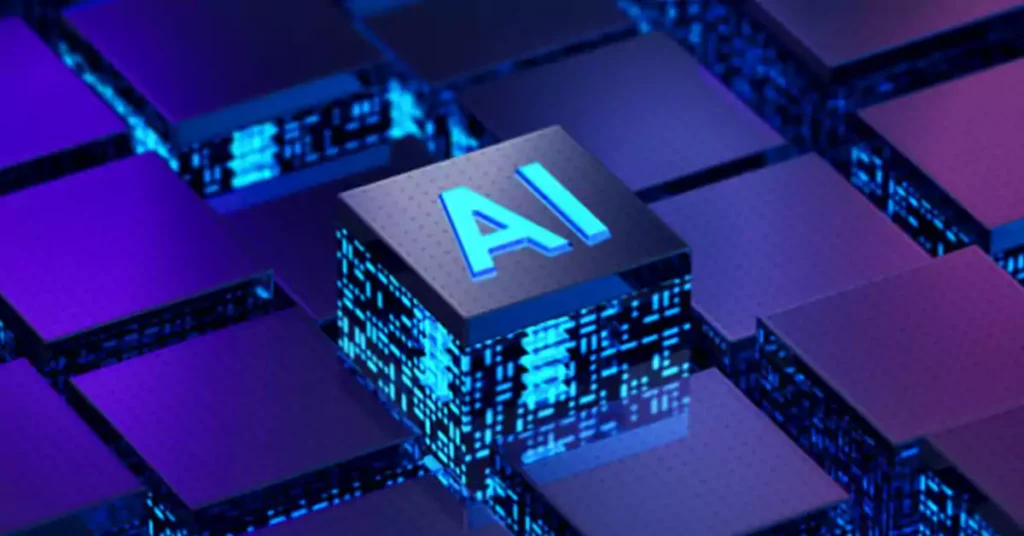
To tackle these energy challenges, data centers are embracing innovative solutions:
- Energy-Efficient Power Systems: Utilizing high-efficiency uninterruptible power supplies (UPS) and energy-optimized power converters can significantly reduce energy waste and ensure stable power delivery.
- Renewable Energy Solutions: Integrating renewable energy sources such as solar and wind power can help offset the environmental impact. Data centers are increasingly investing in on-site renewable energy generation and strategic partnerships with green energy providers.
- Smart Cooling Technologies: Implementing advanced cooling methods, like liquid cooling and hot/cold aisle containment, helps minimize the energy needed for cooling while maintaining safe operating temperatures for high-density computing.
- AI-Powered Energy Management: Leveraging AI to manage energy distribution within data centers allows for real-time monitoring, predictive analysis, and adaptive power management, improving overall energy efficiency.
- Edge Computing Strategies: Edge computing moves computation closer to the data source, reducing the load on central data centers and minimizing data transfer energy use. This approach distributes workloads more evenly and helps lower overall energy consumption.
The rise of AI has revolutionized industries but also presented considerable challenges in power consumption and energy management for data centers. Addressing these issues involves a combination of cutting-edge technology, sustainable practices, and innovative strategies to ensure that data centers can meet AI’s growing demands while maintaining energy efficiency and minimizing environmental impact.
AI Data Centers vs. Traditional Data Centers
As artificial intelligence (AI) continues to transform industries, it is reshaping the infrastructure of data centers across the globe. While traditional data centers have been built to handle general-purpose workloads, AI data centers are specifically designed to support the computationally intensive demands of AI applications, such as machine learning and deep learning. The differences between these two types of data centers are vast, especially when it comes to their power systems. In this section, we will explore how AI data centers differ from traditional data centers, focusing on the core factors that make power systems so essential to AI workloads.
Computational Power and Infrastructure
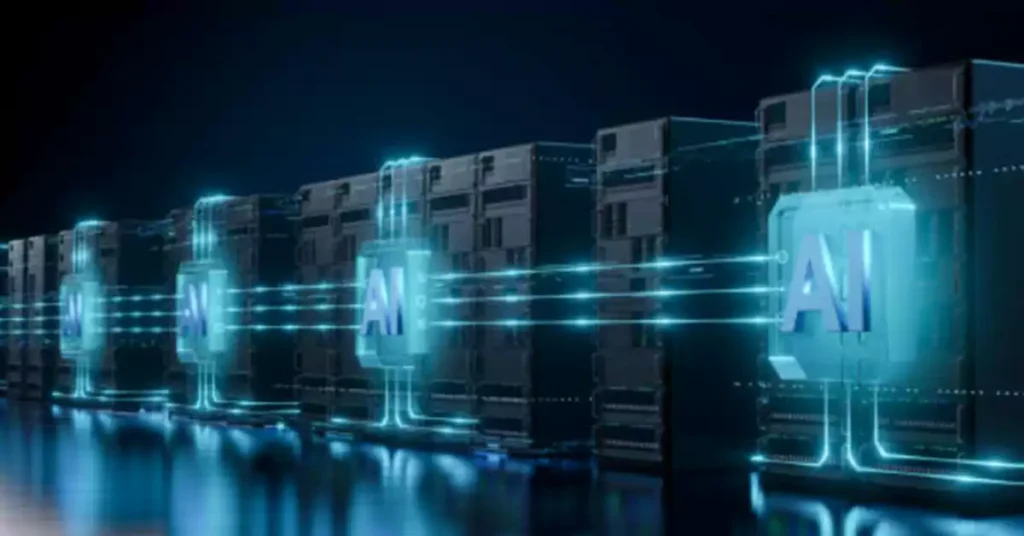
Traditional Data Centers:
In normal data centers, the infrastructure is designed to support a wide variety of general-purpose computing applications, such as web hosting, email, file storage, and enterprise applications. The computing resources are generally consistent, with servers relying primarily on central processing units (CPUs). These servers are optimized for efficiency and reliability, supporting predictable workloads that require stable computational power over time. Power infrastructure in normal data centers is typically built with redundancy and high reliability to maintain operations for critical business applications.
AI Data Centers:
AI data centers, on the other hand, are designed to handle highly specialized and computationally intensive tasks. AI workloads—such as training machine learning models, performing natural language processing, and conducting deep learning operations—require specialized hardware. This often includes not only high-performance CPUs but also Graphics Processing Units (GPUs) and Tensor Processing Units (TPUs), which excel at parallel processing. These components provide the immense computational power needed for AI training, which can involve billions of parameters and require significant amounts of electricity.
The power infrastructure in AI data centers must be capable of supporting these advanced processing units, ensuring that they operate at peak efficiency while managing the high computational demands. Additionally, AI workloads often exhibit irregular power consumption patterns, with significant power spikes during intensive training cycles.
Energy Consumption and Efficiency
Normal Data Centers:
The power consumption in traditional data centers is relatively steady and predictable. These centers manage a broad range of general-purpose applications that have consistent energy requirements. While energy efficiency remains a priority, the overall demand for power in traditional data centers is lower and less complex than in AI-driven facilities.
AI Data Centers:
In contrast, AI data centers experience significantly higher energy consumption due to the massive computational power required for AI workloads. For instance, training a large-scale AI model can consume up to 10 times more energy than a conventional data center. AI data centers must be optimized not only for performance but also for energy efficiency to mitigate their substantial environmental impact.
Given the immense energy demands of AI data centers, energy efficiency technologies and advanced power management systems are essential. AI data centers are increasingly adopting innovative solutions such as AI-driven power management, real-time monitoring, and smart grid integration to optimize energy consumption and reduce wastage.
Cooling and Thermal Management
Traditional Data Centers:
Traditional data centers use conventional cooling methods like Computer Room Air Conditioning (CRAC) units, raised floor designs, and hot/cold aisle containment strategies to ensure that equipment remains within safe operating temperatures. These systems are designed to handle the relatively lower heat load generated by general-purpose servers.
AI Data Centers:
However, AI data centers require much more advanced cooling solutions due to the high heat generation associated with high-performance GPUs and TPUs used for deep learning and machine learning. The heat density in AI data centers is significantly higher, often necessitating more sophisticated cooling technologies like liquid cooling or immersion cooling. These methods are far more efficient than traditional air-based systems and can help manage the heat produced by AI workloads without compromising server performance.
Statistic: “Cooling systems in AI data centers can account for up to 40% of the total energy consumption.” – Uptime Institute (2023).
In addition, AI data centers are leveraging advanced thermal management techniques, such as direct liquid cooling, to reduce the environmental footprint associated with cooling. As AI workloads increase, energy-efficient cooling will play an essential role in reducing overall power consumption.
Power Stability and Peak Load Management
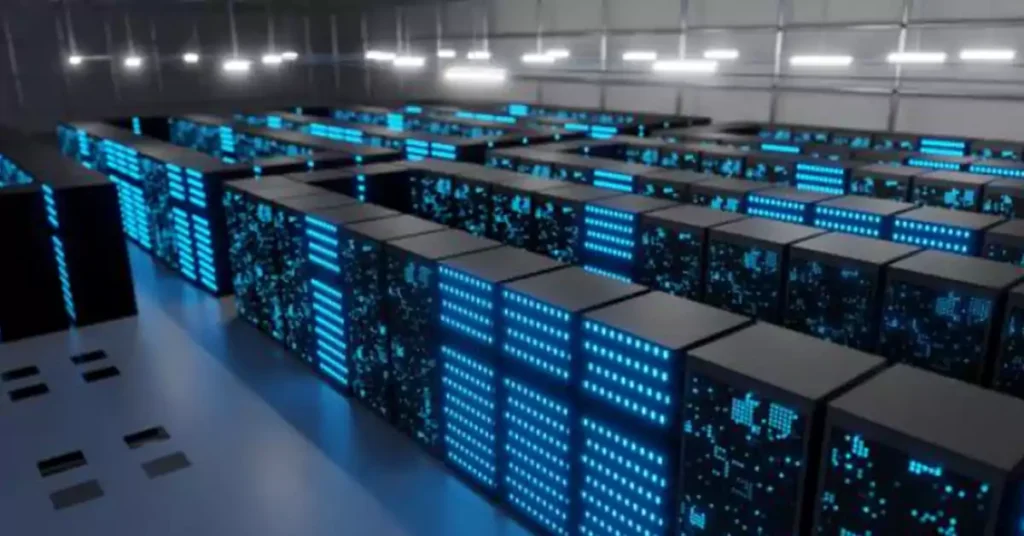
Traditional Data Centers:
Power stability in normal data centers is relatively easier to maintain, as the power demand is predictable. Backup power systems, such as uninterruptible power supplies (UPS) and standby generators, are designed to handle the expected load and ensure reliable operation during power interruptions. Voltage and frequency fluctuations are rare and can generally be managed with standard equipment.
AI Data Centers:
AI data centers, on the other hand, face more significant challenges with managing power stability. The unpredictable nature of AI workloads means that these centers experience highly irregular power consumption. Peak loads often occur during periods of intensive model training, putting additional strain on power systems.
The power infrastructure in AI data centers must be equipped with advanced power management systems capable of handling these sudden surges. This includes real-time monitoring, predictive load management, and integration with advanced grid management systems to ensure the stable operation of the data center despite fluctuations in power demand. On-site energy storage solutions, such as batteries or supercapacitors, are also becoming more common to help smooth out these power spikes and ensure uninterrupted operation during peak demand periods.
Renewable Energy and Sustainability Efforts
Traditional Data Centers:
While traditional data centers are focusing on energy efficiency, the integration of renewable energy sources has been slower. Many traditional data centers still rely heavily on fossil fuels, though there is growing interest in incorporating renewable sources like solar and wind power to reduce their carbon footprint.
AI Data Centers:
AI data centers, given their higher energy demands, are under increasing pressure to adopt sustainable energy practices. These data centers are more likely to integrate renewable energy sources, such as solar panels and wind farms, to offset their carbon emissions. In some cases, AI data centers are partnering with local energy providers to purchase renewable energy credits or build on-site renewable energy generation capabilities to meet their power needs sustainably.
Statistic: “Data centers account for about 1% of global electricity consumption, and this number is projected to rise with the increasing demand for AI processing.” – Greenpeace.
Additionally, AI data centers are exploring energy storage solutions that allow them to capture and store renewable energy when it is abundant, reducing reliance on the grid during peak demand periods. These sustainability efforts are becoming a critical part of the strategy for AI data centers as they work to minimize their environmental impact while supporting the rapidly growing needs of AI workloads.
Electrical Conduit in Data Centers vs. Buildings
When it comes to electrical systems, the type of conduit used plays a crucial role in ensuring the safety, functionality, and efficiency of electrical wiring. While both data centers and traditional buildings rely on electrical conduit to protect wiring, the requirements and characteristics of these environments differ significantly. This section will explore the key differences between electrical conduit used in data centers and traditional buildings, considering the unique demands of each setting.
1. The Role of Conduit in Data Centers and Buildings
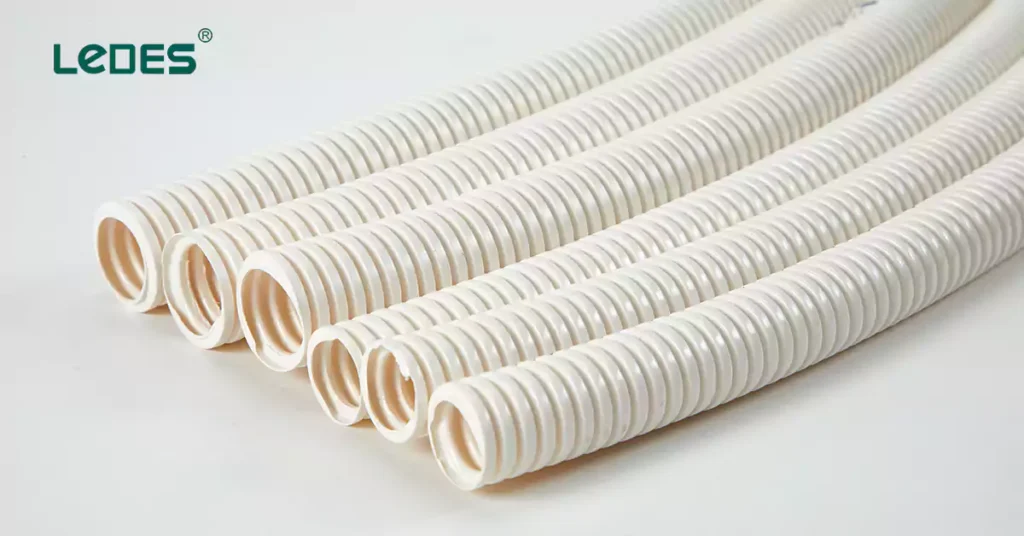
Traditional Building Conduit:
In traditional building construction, electrical conduit serves primarily as protective housing for electrical wiring. Its primary function is to safeguard the electrical conductors from external environmental conditions such as temperature fluctuations, humidity, and physical damage. The conduit is typically installed in walls, ceilings, or floors, ensuring the safety of electrical circuits while allowing for easy maintenance and upgrades.
The types of conduit commonly used in traditional buildings are governed by standards such as the Código Eléctrico Nacional (NEC), which covers conduit installation and general safety requirements. For example, NEC Article 350 outlines the standards for Electrical Metallic Tubing (EMT), often used in residential and light commercial construction.
Data Center Conduit:
In contrast, data centers have more specialized requirements due to the sensitive nature of the equipment housed within them. Data centers require conduit systems that accommodate higher cable densities, support increased power loads, and ensure that the electrical systems function seamlessly under high-demand conditions. The conduit must be capable of handling a large volume of cables for power and data transmission, while also providing fire protection and shielding from electromagnetic interference (EMI).
The environment in a data center is also more controlled than in traditional buildings, with systems designed to manage power supply, cooling, and security. Data center conduits are engineered to ensure that all wiring remains well-organized, safe, and capable of supporting high-performance computing demands. Given the critical importance of minimizing downtime, data center conduit systems are designed with enhanced protection against risks such as fire, moisture, and interference.
2. Design and Materials
Building Conduit:
Traditional building conduit systems are typically made from materials like galvanized steel, Electrical Metallic Tubing (EMT), or PVC (Polyvinyl Chloride). Each material has its advantages, with EMT being lightweight and easy to install, while PVC offers flexibility and resistance to corrosion. The choice of material and sizing depends on local building codes, the specific requirements of the project, and the type of wiring to be used.
Data Center Conduit:
Data center conduit systems, on the other hand, tend to be more robust, utilizing materials like Rigid Metal Conduit (RMC), which offers superior durability and fire resistance. Given the higher electrical and thermal demands of AI, machine learning, and other high-performance computing workloads, RMC is often the preferred choice in data centers due to its ability to withstand the intense conditions.
In areas exposed to moisture, such as cooling systems or areas with high humidity, liquid-tight conduit (LTC) may be used to ensure that the electrical cables remain insulated and protected from corrosive elements. Additionally, data center conduit systems are often designed with rigorous standards in mind, with UL (Underwriters Laboratories) certifications that ensure fire resistance, EMI shielding, and temperature tolerance.
Required Standards:
Data center conduit systems are governed by specific standards beyond general construction codes. For instance, the Telecommunications Industry Association (TIA) and Electronic Industries Alliance (EIA) have established guidelines that inform the design and installation of structured cabling systems, which are commonly used in data centers.
3. Power and Cable Management
In Data Centers:
Data centers require conduit systems that can handle high-power cables and ensure efficient cable routing for both power and data lines. The high density of cables requires more precise and organized installations to maintain signal integrity and avoid interference. Additionally, data center conduits need to integrate with the cooling systems, ensuring that cables remain well-managed and that airflow is optimized.
In Traditional Buildings:
In buildings, the power demands are lower, and there are fewer cables to manage. The conduit system is generally simpler and focuses on standard wiring needs for lighting, power distribution, and basic communications. As a result, the conduit installations in buildings don’t need to handle the same high-density requirements or complex configurations seen in data centers.
4. Cooling Needs: Managing Heat in High-Tech Environments
Data centers generate significant heat due to the high-performance equipment they house, especially when running power-hungry AI workloads or large-scale computing tasks. Conduit systems in data centers must be designed to work with the cooling infrastructure, ensuring that cables and equipment do not overheat.
In Data Centers:
To manage the intense heat generated by servers and other hardware, data center conduit systems must integrate with advanced cooling systems. Conduits need to allow for efficient airflow and support specialized cooling solutions, such as liquid cooling or immersion cooling, which are not typically used in traditional buildings.
In Traditional Buildings:
While buildings do have HVAC systems, the cooling needs are much less intense than in data centers. The conduit system in a building does not need to manage the same level of heat, and the focus is generally on maintaining safe, reliable wiring without integrating complex cooling solutions.
5. Installation Practices Difference

Traditional Building Conduit:
In traditional buildings, electrical conduit installation typically follows standard wiring practices and local building codes. Installation involves running wires through walls, floors, or ceilings, with particular attention paid to ensuring that fire safety codes are met. While conduit installation is generally straightforward, it must also account for future access needs and ease of maintenance.
Data Center Conduit:
In data centers, conduit installation is a more precise and organized process. The high density of cables, complex routing requirements, and the need for uninterrupted power and data flow demand a more sophisticated approach. Structured cabling methodologies, such as horizontal cable trays and vertical cable runs, are used to manage cables efficiently and maintain optimal airflow, which is crucial for cooling and system reliability.
The wiring system in a data center is designed to be highly organized, minimizing the risk of physical damage to cables and ensuring ease of access for maintenance or upgrades. Conduit in data centers often needs to be installed in a way that facilitates rapid expansion or modification, as data center environments are subject to continuous growth and technological upgrades.
6. Evolution of Conduit Systems
Building Conduit:
As traditional buildings become “smarter,” with more integrated systems for lighting, HVAC, and security, the demand for advanced electrical conduit systems is also growing. Smart buildings require conduit systems that can support integrated sensors, power control systems, and data transmission lines. These systems will increasingly incorporate real-time monitoring and automated controls to improve energy efficiency and building management.
Data Center Conduit:
For data centers, the future of conduit systems is focused on greater flexibility and scalability. As AI workloads and data processing demands continue to rise, data center designs must evolve to accommodate higher power loads and more extensive cabling systems. Modular conduit systems, capable of expanding as the data center grows, are expected to become more prevalent. Additionally, the integration of smart conduit systems with sensors for real-time monitoring, cable health checks, and fault detection will help ensure the reliability and efficiency of data center operations.
Sustainability will also be a key driver in the evolution of conduit systems in both buildings and data centers. As renewable energy sources become more integrated into power grids, both types of facilities will require conduit solutions that support energy-efficient electrical systems and minimize environmental impact.
Why Electrical Conduit is Crucial for Data Centers
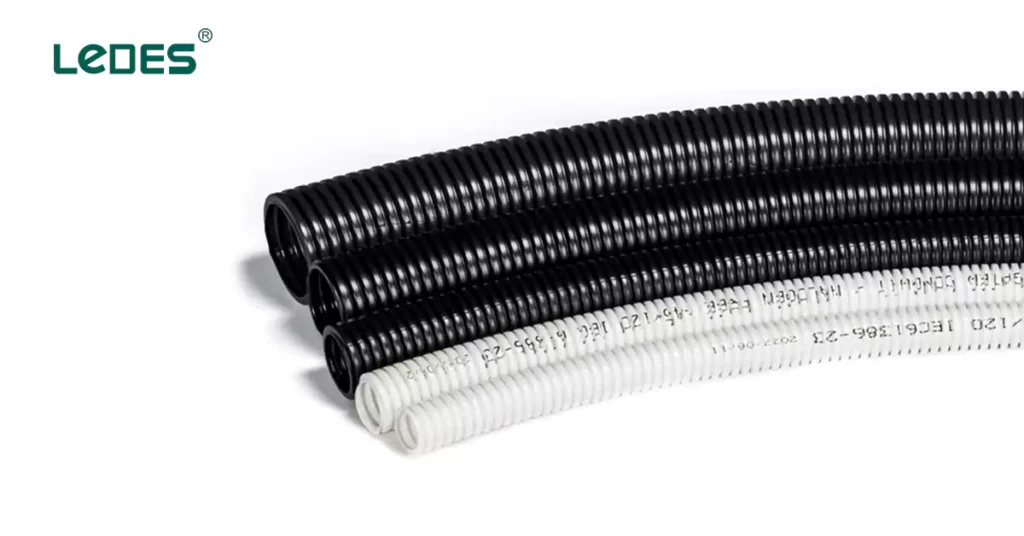
Electrical conduit systems play a vital role in the safe and efficient operation of data centers. These systems protect, organize, and manage the complex network of cables powering the data center’s operations.
1. Protecting Cables from Damage
Data centers contain thousands of cables that provide power, data connections, and network links. Without proper protection, these cables are vulnerable to physical damage, electrical faults, or environmental factors like moisture, dust, and temperature changes.
Electrical conduit protects these cables, reducing the risk of damage that could cause service disruptions or downtime. Conduit shields cables from physical impacts, wear and tear, and environmental hazards, ensuring that the power and data systems remain reliable and operational.
2. Managing High-Density Cabling
Data centers handle vast amounts of data and run numerous computing systems. This requires a dense network of cables to connect everything. Unlike traditional buildings, data centers have much higher cable volumes.
Electrical conduit helps organize and manage these cables, preventing tangles and ensuring everything is routed properly. By keeping cables neat and out of the way, conduit systems help maximize space and make it easier to maintain or upgrade systems. An organized system also ensures that cables don’t interfere with airflow or cooling.
3. Ensuring Fire Safety
With the high volume of electrical equipment in data centers, fire safety is critical. Electrical faults, overheating, or equipment failure can lead to fires, which can quickly spread and damage valuable equipment.
Conduits are often made from fire-resistant materials, such as rigid metal conduit (RMC), to prevent the spread of fire. These materials help contain fires, protect sensitive equipment, and comply with safety regulations. Fire-resistant conduit reduces the risk of catastrophic damage and ensures that the data center meets strict fire safety standards.
4. Shielding Against Electromagnetic Interference (EMI)
Data centers rely on many electrical signals that can interfere with one another. Electromagnetic interference (EMI) can cause data transmission issues, disrupt operations, and damage sensitive equipment.
Electrical conduit, especially those made of metal, provides shielding against EMI. This helps maintain stable power and data transmission, ensuring that the equipment functions properly. With well-protected cables, data centers can prevent disruptions and keep operations running smoothly.
5. Supporting Growth and Flexibility
Data centers are dynamic environments that need to adapt to rapidly changing technology and increasing demands. As new equipment is added, the electrical infrastructure must expand to support the increased load.
Electrical conduit systems are designed to be flexible and scalable. They allow data centers to easily add new cables as they grow. This adaptability ensures that data centers can meet the evolving needs of technology without major infrastructure changes. Conduit also helps organize cables for future upgrades, making the process more efficient and cost-effective.
6. Enhancing Operational Efficiency
Efficient operations are essential in data centers. Poor cable management can block airflow, increase cooling costs, and lead to equipment overheating.
By organizing cables with conduit systems, data centers can improve airflow and cooling efficiency. Properly installed conduits ensure that cables don’t obstruct cooling systems, which helps maintain the ideal temperature for equipment. This reduces energy consumption and improves overall efficiency.
7. Supporting Cooling Systems
Cooling is critical to maintaining optimal conditions in a data center. Overheating can cause hardware failure and disrupt service. The complexity of cooling systems in data centers requires well-organized cable management to ensure that air circulation is unhindered and cooling systems perform efficiently.
Electrical conduit systems play an important role in supporting temperature regulation by keeping cables organized and out of the way of air and cooling ducts. By ensuring proper airflow, conduit systems help cooling units, such as CRAC (Computer Room Air Conditioning) systems or liquid cooling, to function more efficiently. In high-density environments, reducing cable clutter allows the cooling systems to work effectively, helping to prevent overheating and keeping energy consumption in check.
8. Easing Maintenance and Reduced Downtime
Data centers are constantly evolving, with new technologies and upgrades being implemented regularly. The ability to easily access and maintain cables is crucial for minimizing downtime.
Conduit systems make cable management easy, helping technicians quickly locate and maintain cables. With clear organization, they can perform routine checks, replace outdated cables, and upgrade systems without disrupting operations. This helps data centers stay efficient and up-to-date as technology continues to evolve.
4 Types of Conduit Used in Data Centers
The choice of conduit in data centers is influenced by factors like durability, fire resistance, ease of installation, and cost. Each type of conduit has its strengths and potential risks, making it essential for data center planners to understand their specific needs and constraints. Here, we explore the main types of conduit used in data centers, analyze their benefits and drawbacks, and offer insight into why they might be chosen for certain applications.
Ventajas:
Affordable: Cost-effective for large installations.
Ligero: Easy to cut and install, saving time and labor.
Resistente a la corrosión: Doesn’t rust, making it reliable in various conditions.
Contras:
Heat Sensitivity: Can melt or burn in high temperatures, posing a fire risk.
Low Strength: More prone to physical damage than metal options.
No EMI Protection: Doesn’t shield against electromagnetic interference, which can be an issue in high-density power areas.
Objetivo: Low-voltage areas or non-critical applications where cost savings are a priority.
Steel Conduit
Ventajas:
Resistente al fuego: Can withstand high temperatures without melting.
Durable: Offers excellent mechanical protection.
EMI Shielding: Helps protect cables from electromagnetic interference.
Contras:
Heavy: Difficult to handle and install, increasing labor time and effort.
Potential to Rust: Even galvanized steel can corrode over time without proper maintenance.
Higher Cost: More expensive than non-metallic options.
Objetivo: High-power areas, main power feeds, or places needing strong fire protection.
Fiberglass Conduit
Ventajas:
Lightweight and Strong: Easier to handle than steel but more robust than PVC.
No conductor: Reduces the risk of electric shock.
Heat-Resistant: Performs well in higher temperatures.
Contras:
Can Become Brittle: May weaken over time, especially under mechanical stress.
More Expensive than PVC: But usually less costly than steel.
Special Installation: May need specific tools for cutting.
Objetivo: Areas needing a balance between durability and lightweight properties, such as cable trays near high-power servers.
Flexible Metal and Liquid-Tight Conduit
Ventajas:
Highly Flexible: Easy to install in tight or irregular spaces.
Moisture Protection: Liquid-tight versions provide extra protection against water.
Adaptable: Ideal for connecting equipment that might move or be maintained regularly.
Contras:
Less Durable: Not as strong as rigid metal conduits.
Lower Fire Resistance: May not be suitable for areas with high fire risk.
Potential Wear: Can degrade faster in high-traffic areas.
Objetivo: Areas requiring flexible connections or moisture resistance, like zones near cooling systems or movable equipment.
4 Types of Electircal Conduit in Data Centers
Aspect |
Conducto de PVC |
Steel Conduit |
Fiberglass Conduit | Flexible & Liquid-Tight Conduit |
Resistencia al fuego | No | Sí | Sí | Limited |
Durability | Moderate | High | High | Moderate |
Weight | Light | Heavy | Light | Light |
Resistencia a la corrosión | High | Moderate(with coating) | High | High |
Costo | Low | High | Moderate | Moderate |
EMI Shielding | No | Sí | Limited | Limited |
Heat Resistance | Low | High | High | Limited |
Flexibility | Low | Low | Low | High |
Moisture Protection | Low | Moderate | High | High |
Compliance and Standards for Conduits
Proper compliance with industry regulations and standards is crucial when selecting conduit systems for data centers. The following are key codes and certifications that should be met:
NEC (Código Eléctrico Nacional): The NEC provides comprehensive guidelines for electrical conduit installation, addressing aspects such as fire safety, grounding, and installation practices. Data center designs must align with NEC standards to ensure safe and efficient electrical infrastructure.
UL (Underwriters Laboratories): Conduit materials used in data centers often require UL certification. This certification confirms that the conduit meets stringent requirements for fire resistance, electrical safety, and durability. UL-listed conduits provide assurance that they can withstand specific environmental and operational conditions.
TIA/EIA Standards: The Telecommunications Industry Association (TIA) and the Electronic Industries Alliance (EIA) set standards for structured cabling systems, including conduit usage in telecommunications and data centers. These standards ensure that conduit installations do not interfere with signal transmission and that they support organized and efficient cable routing.
Ledes Data Center Conduit Solutions
Acerca de Ledes
Ledes is a recognized manufacturer of high-quality conduit systems tailored to meet the stringent demands of modern data centers and electrical infrastructure projects. With a reputation built on innovation, durability, and adherence to international standards such as UL, CSA, AS/NZS, IEC, and CE, Ledes provides reliable solutions that cater to a wide range of applications, including data centers requiring robust, adaptable conduit systems for efficient cabling and safety management.
Ledes' Australian Standard Communication Conduits
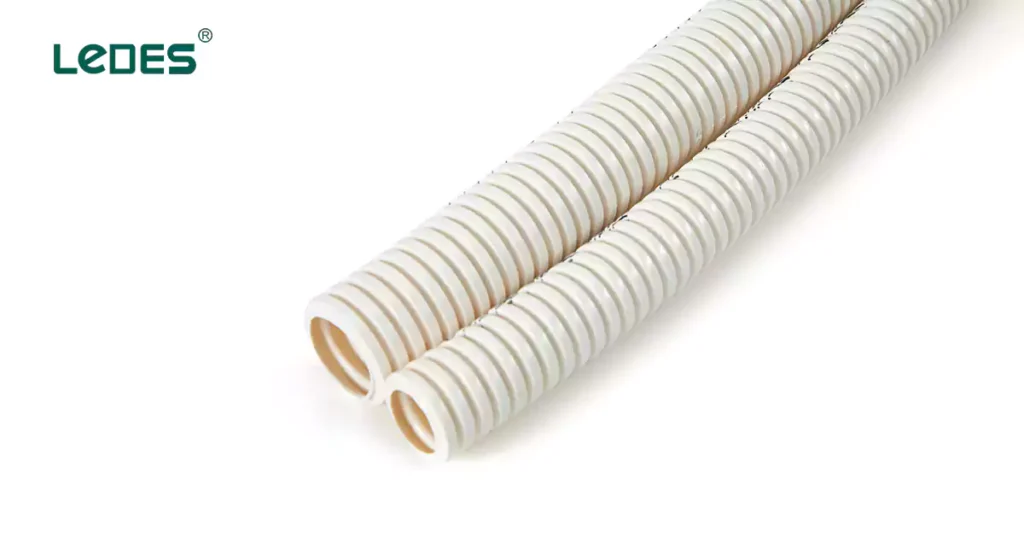
Ledes produces communication conduits that comply with the rigorous Australian standards, ensuring top-notch quality and resilience. These conduits are specifically designed to manage and protect network cables, preventing signal loss and minimizing risks associated with electromagnetic interference (EMI). The Australian standard communication conduits offered by Ledes are known for:
- High Durability: Engineered to withstand harsh conditions while maintaining optimal performance.
- Facilidad de instalación: Lightweight and designed for quick, seamless setup.
- Resistencia al fuego: Ideal for indoor and outdoor applications in data centers, where fire safety and exposure to elements are critical considerations.
Ledes American Standard Schedule 40 and 80 Conduits

For data centers in regions requiring American standards, Ledes provides Schedule 40 and Schedule 80 PVC conduits:
- Schedule 40 Conduits: These are known for their balance between cost and durability, making them suitable for standard installations where moderate mechanical protection is needed. They are easy to install and offer good flame-retardant properties.
- Schedule 80 Conduits: With thicker walls, these conduits provide enhanced mechanical protection, making them ideal for high-stress environments within data centers that might face potential impacts or heavier loads.
Both types adhere to industry norms and ensure the safe routing of electrical wiring and network cables, providing consistent insulation and minimizing the risk of electrical faults.
Accesorios para conductos
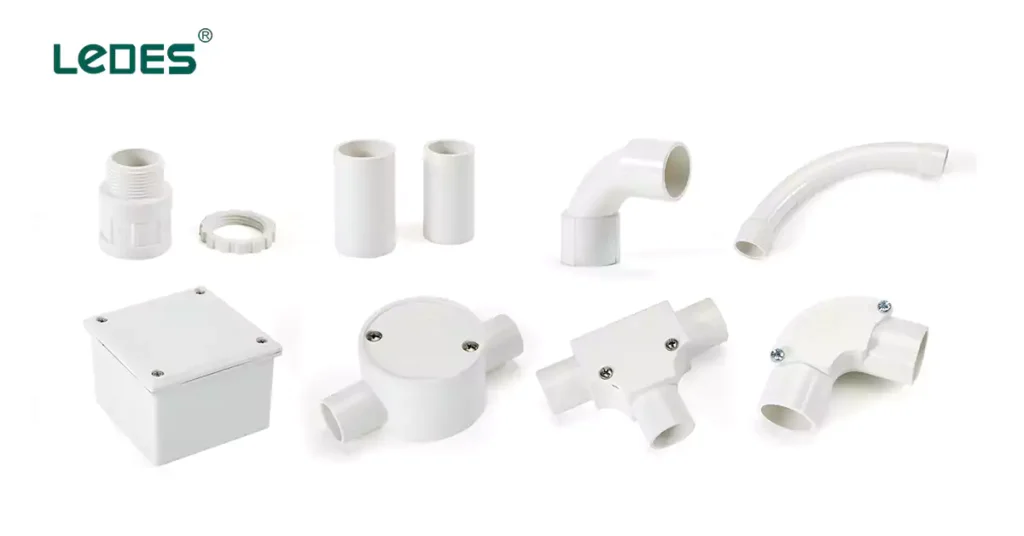
Ledes complements its conduit offerings with a range of essential electrical fittings designed to ensure comprehensive, seamless conduit systems:
- Codos: Engineered to allow for smooth directional changes in conduit pathways without compromising on cable integrity.
- Acoplamientos: Secure and reinforce conduit connections, ensuring continuous protection along the entire cable path.
- Boxes: Provide junction points for connections, facilitating maintenance and easy upgrades of the electrical infrastructure.
And there are couplings, adapters, junction boxes many other fittings for using with conduit installation in data center.
These accessories are designed with the same high standards of durability and compliance, ensuring that data centers maintain uninterrupted operations and support complex network configurations.
Conclusión
In conclusion, electrical conduit systems play a vital role in the efficient, safe, and reliable operation of data centers. As data centers evolve to meet the increasing demands of AI, cloud computing, and high-performance applications, the importance of choosing the right conduit material and adhering to compliance standards becomes even more critical. Whether using PVC, steel, fiberglass, or flexible metal conduits, each material offers distinct advantages and potential challenges that must be carefully considered to meet the unique needs of a data center environment. Additionally, strict compliance with regulations such as the NEC, UL, and TIA/EIA standards ensures that these systems perform optimally while maintaining safety and durability. By selecting high-quality conduits, incorporating advanced cooling solutions, and ensuring proper installation, data centers can safeguard their infrastructure, support future growth, and minimize downtime risks. Choose suppliers that provide reliable solutions tailored to these needs, data centers can stay ahead of the curve in an increasingly demanding technological landscape.



